BN303 Wireless Network Security: Enterprise WLAN Design Report
VerifiedAdded on 2023/06/11
|12
|1984
|92
Report
AI Summary
This report presents a network design proposal for ABC Technology Institution, which has two campuses 2.5 km apart in Canberra. The design focuses on implementing a wireless network that allows users, including students and administration, to access the network using mobile devices and wired connections. The network requirements include wireless access, wired and wireless access for administration, automatic IP address allocation via DHCP, monitoring of downloaded materials, reporting of inappropriate downloads, guest wireless access without authentication, and adequate security for logged-in users, with scalability for a 6% user growth in the next five years. The report details the network floor plans for both campuses, IP address design, network topology, hardware and software analysis, and the selection of fiber optic cable as the preferred link between campuses due to its high-speed data transmission, low electromagnetic interference, and long-distance signal transmission capabilities. Security measures such as authentication, VPN usage, and encryption are proposed to ensure network integrity and security. The report concludes that the proposed network implementation will enhance accessibility and security for all staff and students within the campus compounds.

Wireless Network and Security
[Student name]
[University name]
[Professor Name]
[Date]
[Student name]
[University name]
[Professor Name]
[Date]
Paraphrase This Document
Need a fresh take? Get an instant paraphrase of this document with our AI Paraphraser
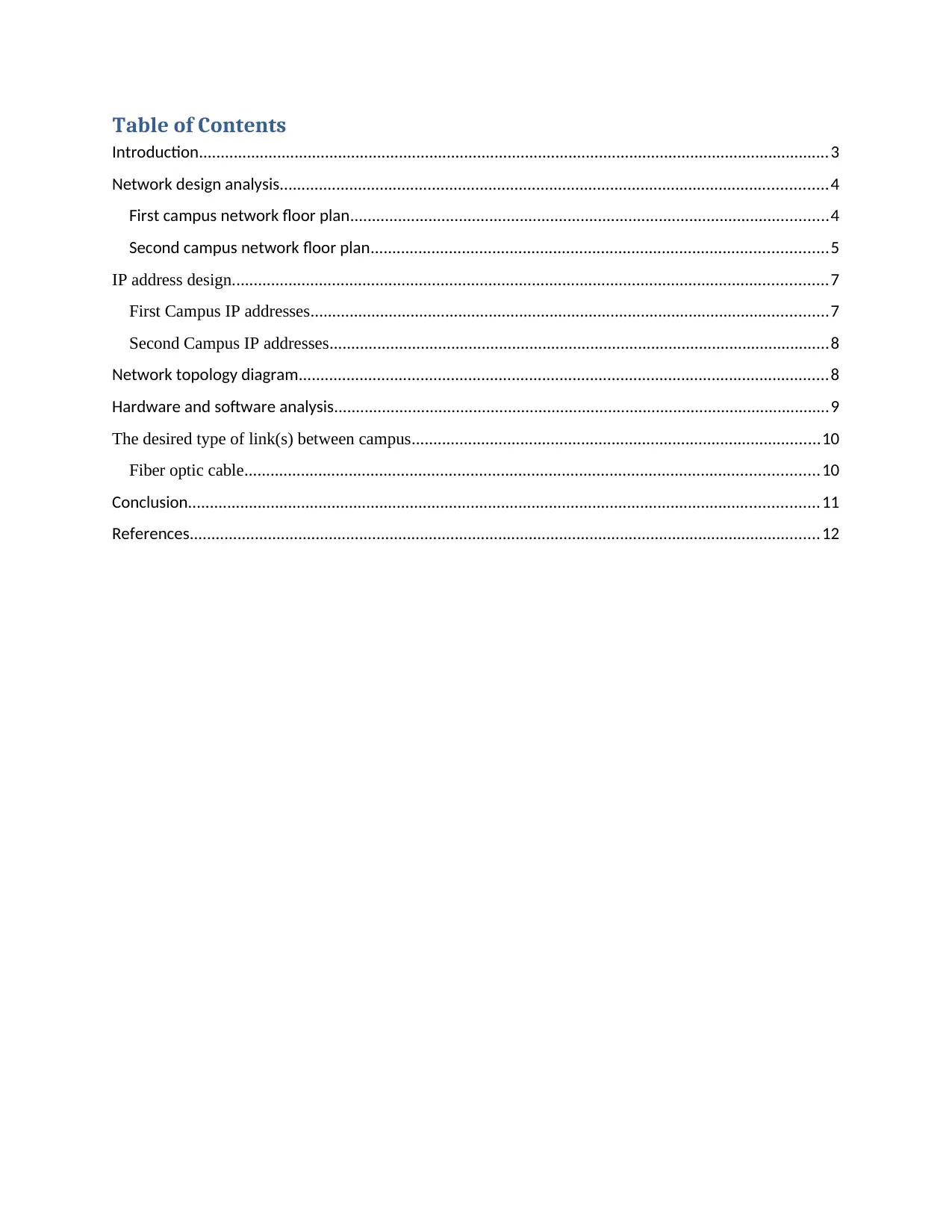
Table of Contents
Introduction.................................................................................................................................................3
Network design analysis..............................................................................................................................4
First campus network floor plan..............................................................................................................4
Second campus network floor plan.........................................................................................................5
IP address design.........................................................................................................................................7
First Campus IP addresses.......................................................................................................................7
Second Campus IP addresses...................................................................................................................8
Network topology diagram..........................................................................................................................8
Hardware and software analysis..................................................................................................................9
The desired type of link(s) between campus..............................................................................................10
Fiber optic cable....................................................................................................................................10
Conclusion.................................................................................................................................................11
References.................................................................................................................................................12
Introduction.................................................................................................................................................3
Network design analysis..............................................................................................................................4
First campus network floor plan..............................................................................................................4
Second campus network floor plan.........................................................................................................5
IP address design.........................................................................................................................................7
First Campus IP addresses.......................................................................................................................7
Second Campus IP addresses...................................................................................................................8
Network topology diagram..........................................................................................................................8
Hardware and software analysis..................................................................................................................9
The desired type of link(s) between campus..............................................................................................10
Fiber optic cable....................................................................................................................................10
Conclusion.................................................................................................................................................11
References.................................................................................................................................................12
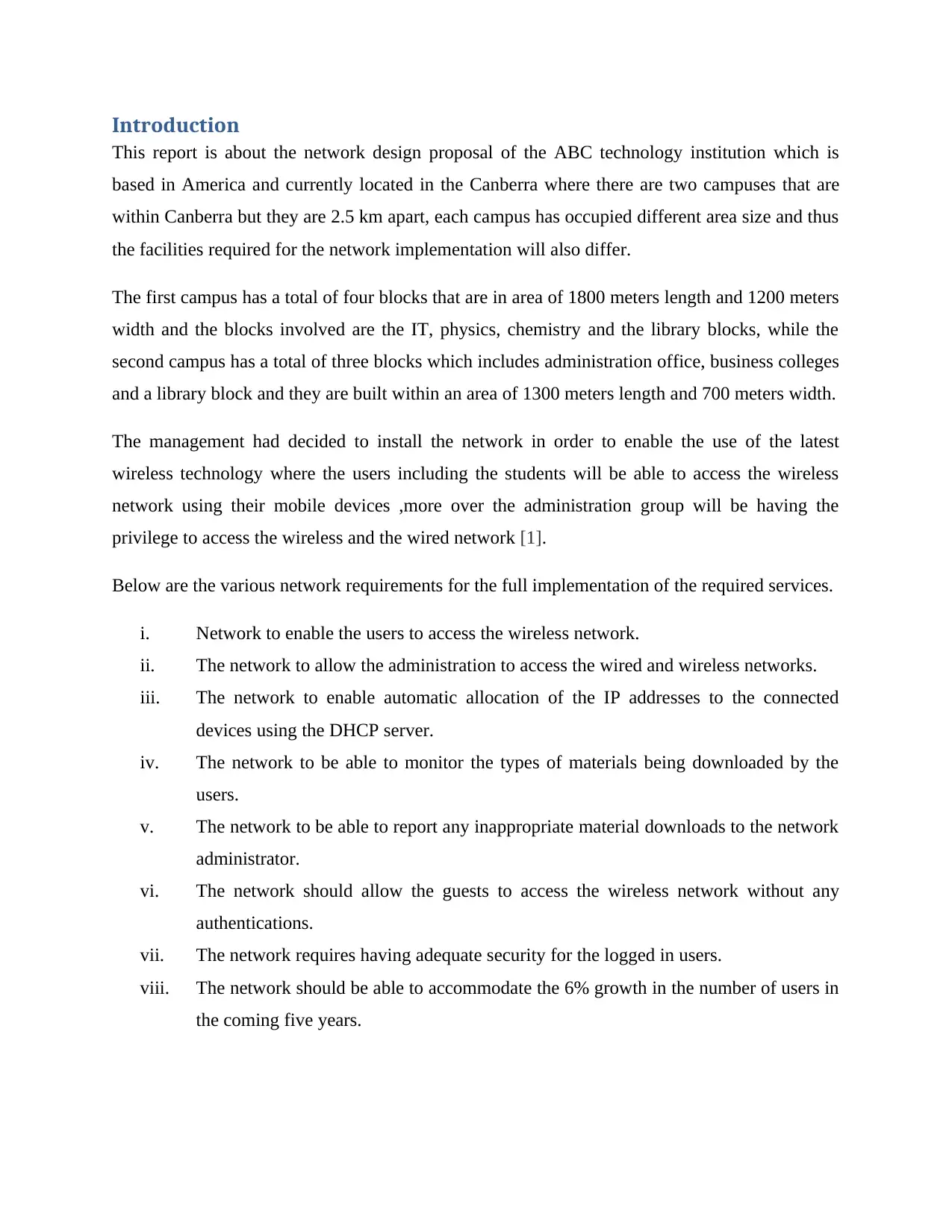
Introduction
This report is about the network design proposal of the ABC technology institution which is
based in America and currently located in the Canberra where there are two campuses that are
within Canberra but they are 2.5 km apart, each campus has occupied different area size and thus
the facilities required for the network implementation will also differ.
The first campus has a total of four blocks that are in area of 1800 meters length and 1200 meters
width and the blocks involved are the IT, physics, chemistry and the library blocks, while the
second campus has a total of three blocks which includes administration office, business colleges
and a library block and they are built within an area of 1300 meters length and 700 meters width.
The management had decided to install the network in order to enable the use of the latest
wireless technology where the users including the students will be able to access the wireless
network using their mobile devices ,more over the administration group will be having the
privilege to access the wireless and the wired network [1].
Below are the various network requirements for the full implementation of the required services.
i. Network to enable the users to access the wireless network.
ii. The network to allow the administration to access the wired and wireless networks.
iii. The network to enable automatic allocation of the IP addresses to the connected
devices using the DHCP server.
iv. The network to be able to monitor the types of materials being downloaded by the
users.
v. The network to be able to report any inappropriate material downloads to the network
administrator.
vi. The network should allow the guests to access the wireless network without any
authentications.
vii. The network requires having adequate security for the logged in users.
viii. The network should be able to accommodate the 6% growth in the number of users in
the coming five years.
This report is about the network design proposal of the ABC technology institution which is
based in America and currently located in the Canberra where there are two campuses that are
within Canberra but they are 2.5 km apart, each campus has occupied different area size and thus
the facilities required for the network implementation will also differ.
The first campus has a total of four blocks that are in area of 1800 meters length and 1200 meters
width and the blocks involved are the IT, physics, chemistry and the library blocks, while the
second campus has a total of three blocks which includes administration office, business colleges
and a library block and they are built within an area of 1300 meters length and 700 meters width.
The management had decided to install the network in order to enable the use of the latest
wireless technology where the users including the students will be able to access the wireless
network using their mobile devices ,more over the administration group will be having the
privilege to access the wireless and the wired network [1].
Below are the various network requirements for the full implementation of the required services.
i. Network to enable the users to access the wireless network.
ii. The network to allow the administration to access the wired and wireless networks.
iii. The network to enable automatic allocation of the IP addresses to the connected
devices using the DHCP server.
iv. The network to be able to monitor the types of materials being downloaded by the
users.
v. The network to be able to report any inappropriate material downloads to the network
administrator.
vi. The network should allow the guests to access the wireless network without any
authentications.
vii. The network requires having adequate security for the logged in users.
viii. The network should be able to accommodate the 6% growth in the number of users in
the coming five years.
⊘ This is a preview!⊘
Do you want full access?
Subscribe today to unlock all pages.

Trusted by 1+ million students worldwide
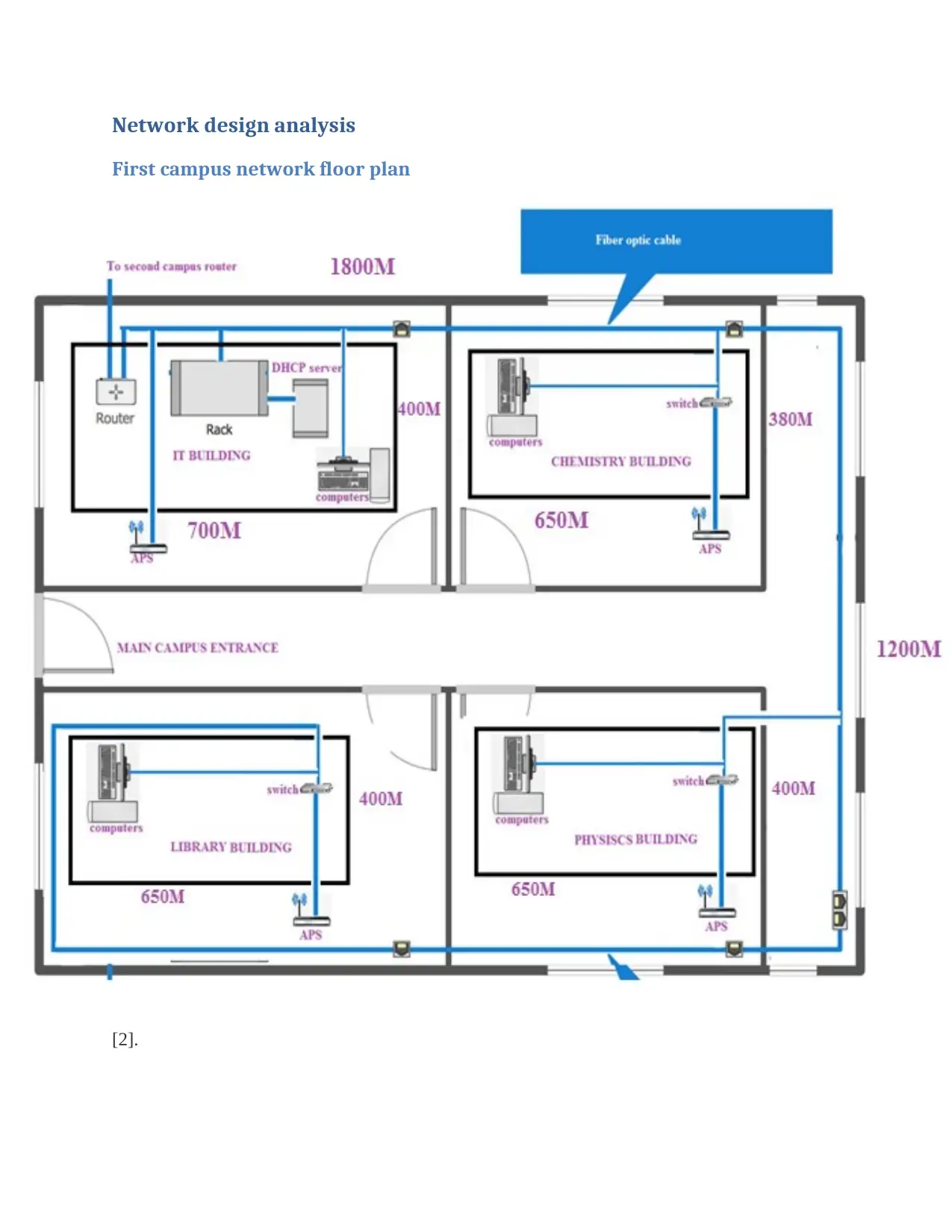
Network design analysis
First campus network floor plan
[2].
First campus network floor plan
[2].
Paraphrase This Document
Need a fresh take? Get an instant paraphrase of this document with our AI Paraphraser
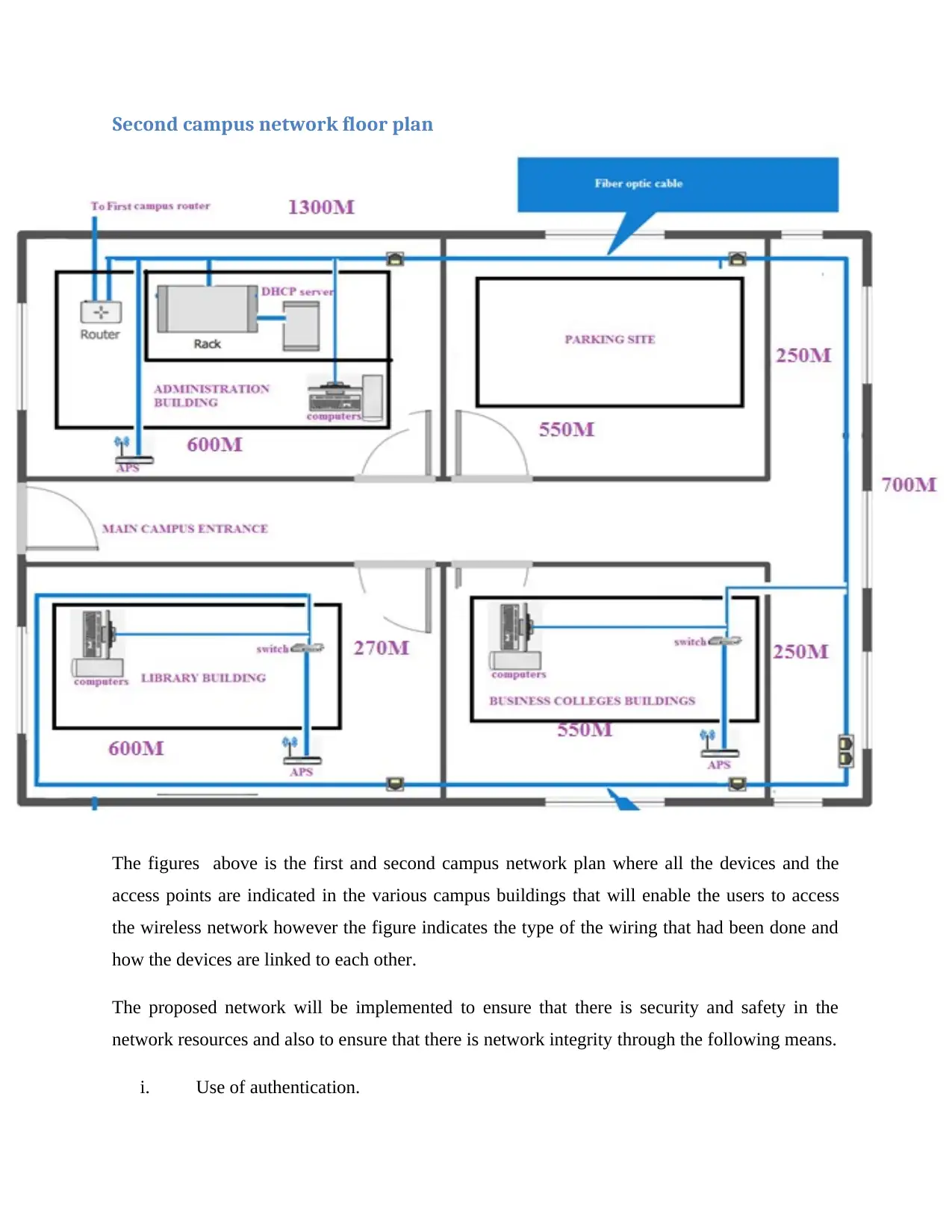
Second campus network floor plan
The figures above is the first and second campus network plan where all the devices and the
access points are indicated in the various campus buildings that will enable the users to access
the wireless network however the figure indicates the type of the wiring that had been done and
how the devices are linked to each other.
The proposed network will be implemented to ensure that there is security and safety in the
network resources and also to ensure that there is network integrity through the following means.
i. Use of authentication.
The figures above is the first and second campus network plan where all the devices and the
access points are indicated in the various campus buildings that will enable the users to access
the wireless network however the figure indicates the type of the wiring that had been done and
how the devices are linked to each other.
The proposed network will be implemented to ensure that there is security and safety in the
network resources and also to ensure that there is network integrity through the following means.
i. Use of authentication.
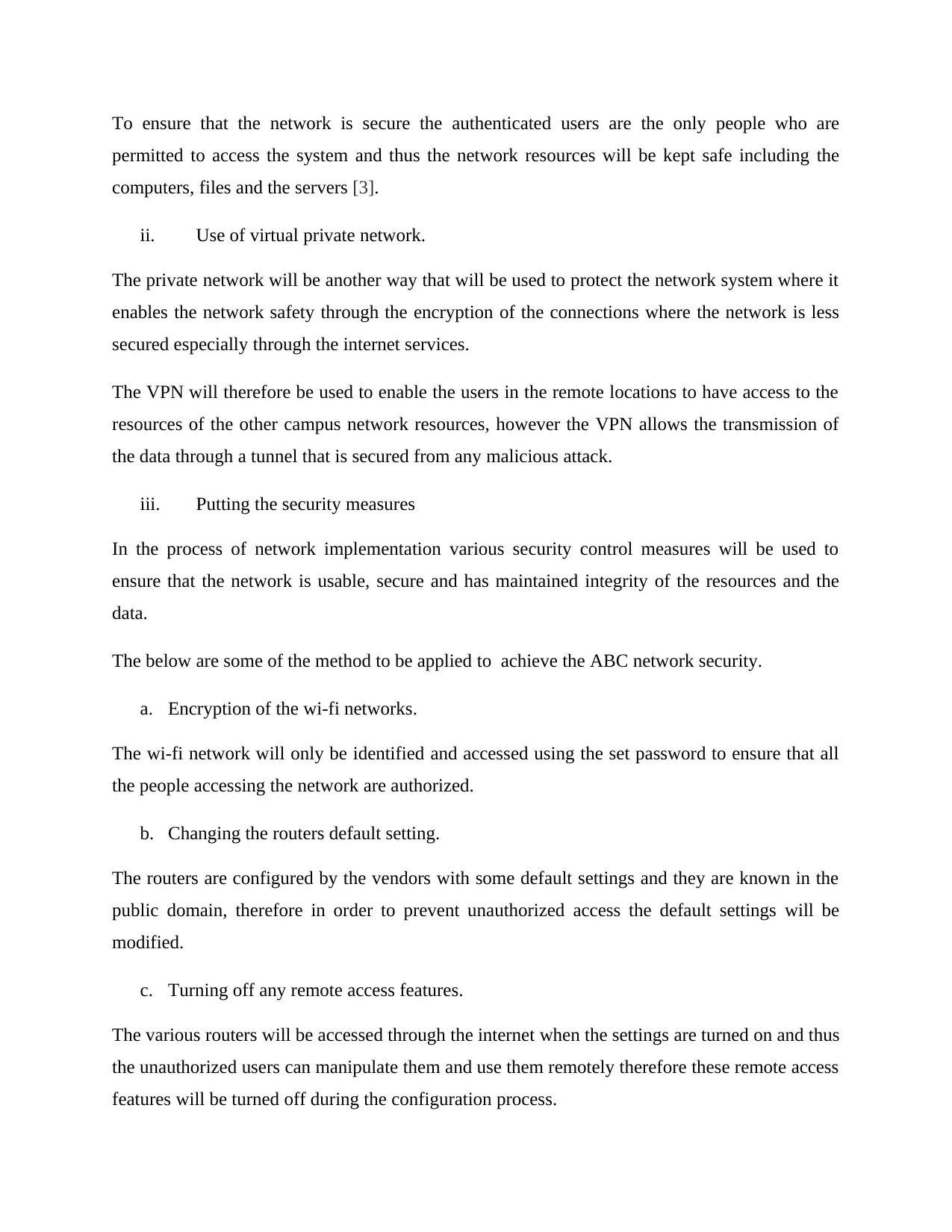
To ensure that the network is secure the authenticated users are the only people who are
permitted to access the system and thus the network resources will be kept safe including the
computers, files and the servers [3].
ii. Use of virtual private network.
The private network will be another way that will be used to protect the network system where it
enables the network safety through the encryption of the connections where the network is less
secured especially through the internet services.
The VPN will therefore be used to enable the users in the remote locations to have access to the
resources of the other campus network resources, however the VPN allows the transmission of
the data through a tunnel that is secured from any malicious attack.
iii. Putting the security measures
In the process of network implementation various security control measures will be used to
ensure that the network is usable, secure and has maintained integrity of the resources and the
data.
The below are some of the method to be applied to achieve the ABC network security.
a. Encryption of the wi-fi networks.
The wi-fi network will only be identified and accessed using the set password to ensure that all
the people accessing the network are authorized.
b. Changing the routers default setting.
The routers are configured by the vendors with some default settings and they are known in the
public domain, therefore in order to prevent unauthorized access the default settings will be
modified.
c. Turning off any remote access features.
The various routers will be accessed through the internet when the settings are turned on and thus
the unauthorized users can manipulate them and use them remotely therefore these remote access
features will be turned off during the configuration process.
permitted to access the system and thus the network resources will be kept safe including the
computers, files and the servers [3].
ii. Use of virtual private network.
The private network will be another way that will be used to protect the network system where it
enables the network safety through the encryption of the connections where the network is less
secured especially through the internet services.
The VPN will therefore be used to enable the users in the remote locations to have access to the
resources of the other campus network resources, however the VPN allows the transmission of
the data through a tunnel that is secured from any malicious attack.
iii. Putting the security measures
In the process of network implementation various security control measures will be used to
ensure that the network is usable, secure and has maintained integrity of the resources and the
data.
The below are some of the method to be applied to achieve the ABC network security.
a. Encryption of the wi-fi networks.
The wi-fi network will only be identified and accessed using the set password to ensure that all
the people accessing the network are authorized.
b. Changing the routers default setting.
The routers are configured by the vendors with some default settings and they are known in the
public domain, therefore in order to prevent unauthorized access the default settings will be
modified.
c. Turning off any remote access features.
The various routers will be accessed through the internet when the settings are turned on and thus
the unauthorized users can manipulate them and use them remotely therefore these remote access
features will be turned off during the configuration process.
⊘ This is a preview!⊘
Do you want full access?
Subscribe today to unlock all pages.

Trusted by 1+ million students worldwide
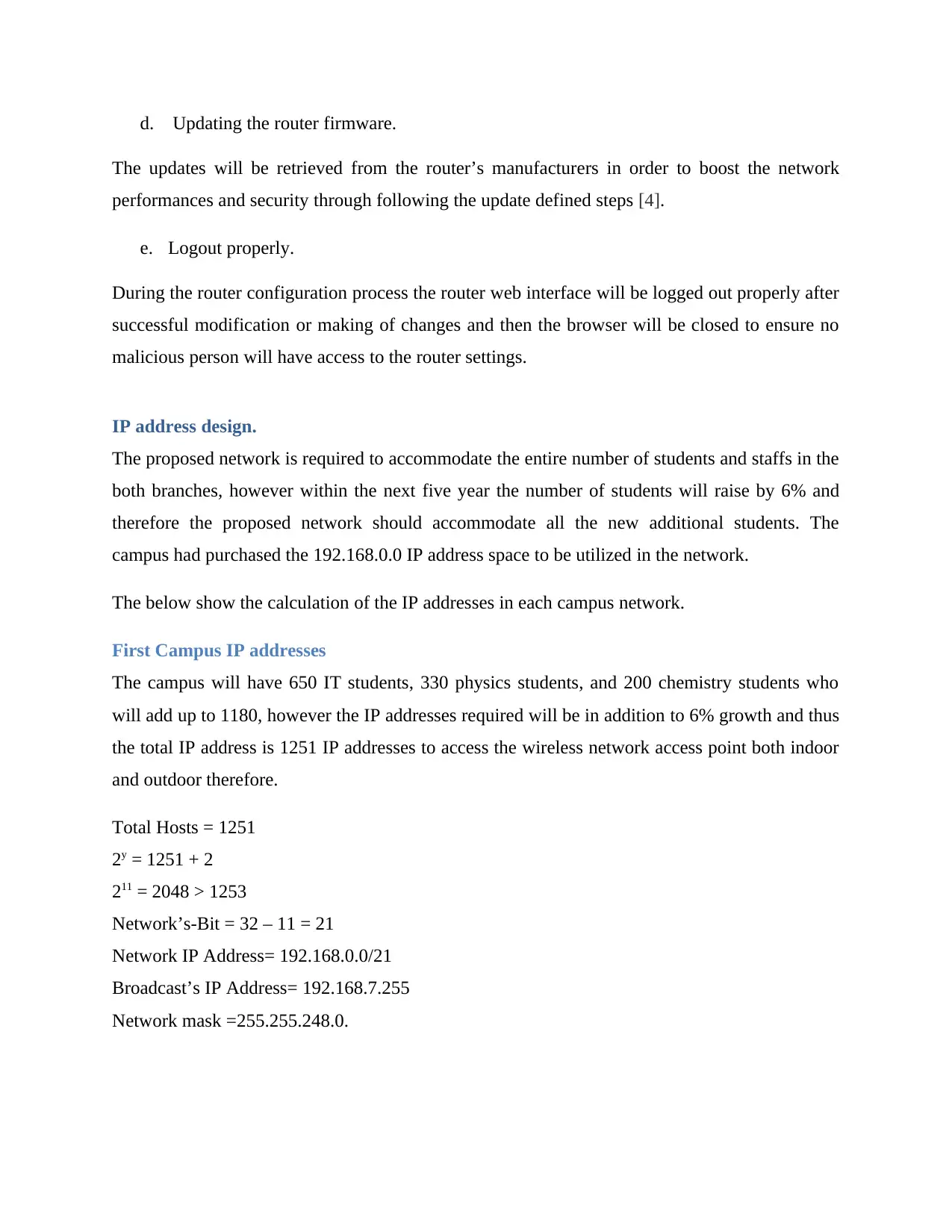
d. Updating the router firmware.
The updates will be retrieved from the router’s manufacturers in order to boost the network
performances and security through following the update defined steps [4].
e. Logout properly.
During the router configuration process the router web interface will be logged out properly after
successful modification or making of changes and then the browser will be closed to ensure no
malicious person will have access to the router settings.
IP address design.
The proposed network is required to accommodate the entire number of students and staffs in the
both branches, however within the next five year the number of students will raise by 6% and
therefore the proposed network should accommodate all the new additional students. The
campus had purchased the 192.168.0.0 IP address space to be utilized in the network.
The below show the calculation of the IP addresses in each campus network.
First Campus IP addresses
The campus will have 650 IT students, 330 physics students, and 200 chemistry students who
will add up to 1180, however the IP addresses required will be in addition to 6% growth and thus
the total IP address is 1251 IP addresses to access the wireless network access point both indoor
and outdoor therefore.
Total Hosts = 1251
2y = 1251 + 2
211 = 2048 > 1253
Network’s-Bit = 32 – 11 = 21
Network IP Address= 192.168.0.0/21
Broadcast’s IP Address= 192.168.7.255
Network mask =255.255.248.0.
The updates will be retrieved from the router’s manufacturers in order to boost the network
performances and security through following the update defined steps [4].
e. Logout properly.
During the router configuration process the router web interface will be logged out properly after
successful modification or making of changes and then the browser will be closed to ensure no
malicious person will have access to the router settings.
IP address design.
The proposed network is required to accommodate the entire number of students and staffs in the
both branches, however within the next five year the number of students will raise by 6% and
therefore the proposed network should accommodate all the new additional students. The
campus had purchased the 192.168.0.0 IP address space to be utilized in the network.
The below show the calculation of the IP addresses in each campus network.
First Campus IP addresses
The campus will have 650 IT students, 330 physics students, and 200 chemistry students who
will add up to 1180, however the IP addresses required will be in addition to 6% growth and thus
the total IP address is 1251 IP addresses to access the wireless network access point both indoor
and outdoor therefore.
Total Hosts = 1251
2y = 1251 + 2
211 = 2048 > 1253
Network’s-Bit = 32 – 11 = 21
Network IP Address= 192.168.0.0/21
Broadcast’s IP Address= 192.168.7.255
Network mask =255.255.248.0.
Paraphrase This Document
Need a fresh take? Get an instant paraphrase of this document with our AI Paraphraser
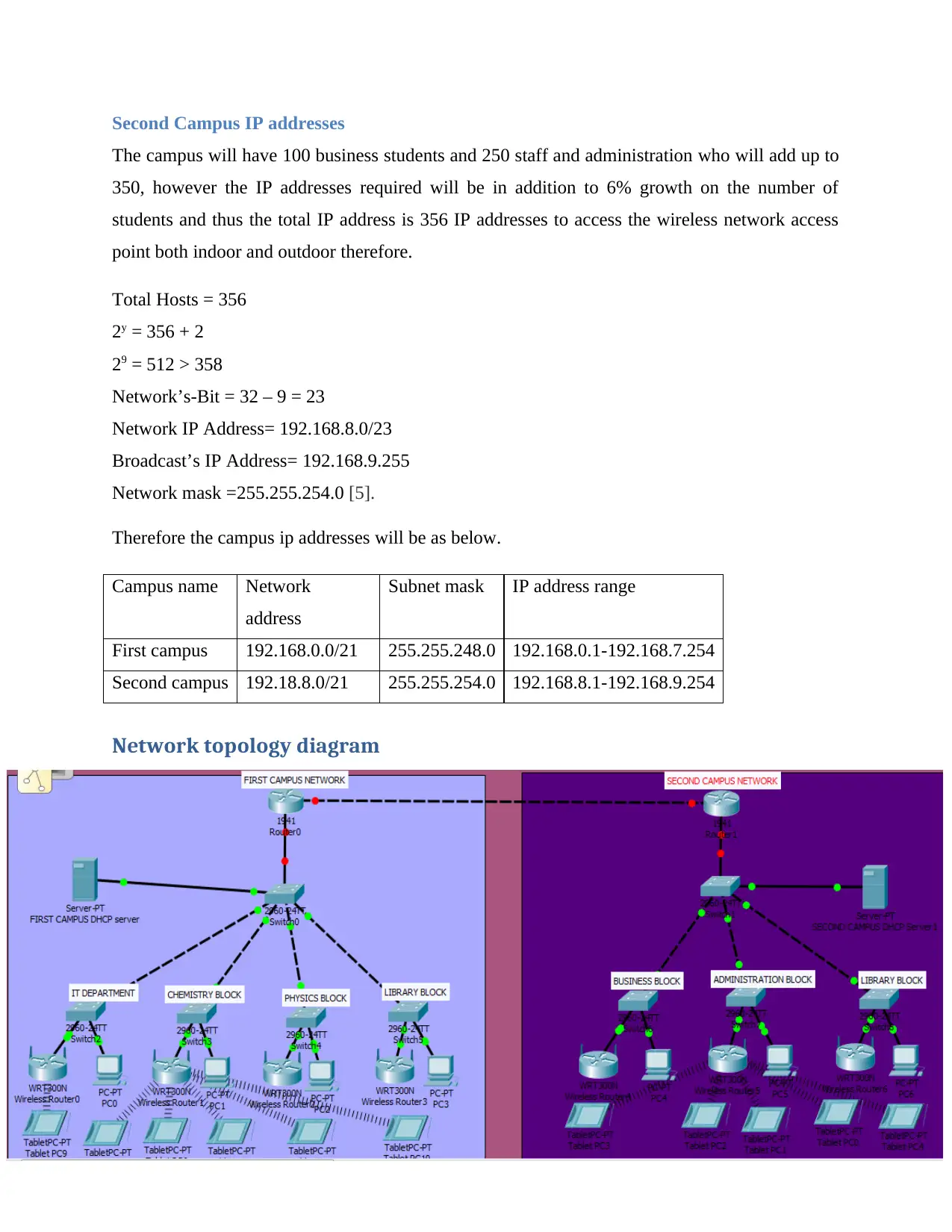
Second Campus IP addresses
The campus will have 100 business students and 250 staff and administration who will add up to
350, however the IP addresses required will be in addition to 6% growth on the number of
students and thus the total IP address is 356 IP addresses to access the wireless network access
point both indoor and outdoor therefore.
Total Hosts = 356
2y = 356 + 2
29 = 512 > 358
Network’s-Bit = 32 – 9 = 23
Network IP Address= 192.168.8.0/23
Broadcast’s IP Address= 192.168.9.255
Network mask =255.255.254.0 [5].
Therefore the campus ip addresses will be as below.
Campus name Network
address
Subnet mask IP address range
First campus 192.168.0.0/21 255.255.248.0 192.168.0.1-192.168.7.254
Second campus 192.18.8.0/21 255.255.254.0 192.168.8.1-192.168.9.254
Network topology diagram
The campus will have 100 business students and 250 staff and administration who will add up to
350, however the IP addresses required will be in addition to 6% growth on the number of
students and thus the total IP address is 356 IP addresses to access the wireless network access
point both indoor and outdoor therefore.
Total Hosts = 356
2y = 356 + 2
29 = 512 > 358
Network’s-Bit = 32 – 9 = 23
Network IP Address= 192.168.8.0/23
Broadcast’s IP Address= 192.168.9.255
Network mask =255.255.254.0 [5].
Therefore the campus ip addresses will be as below.
Campus name Network
address
Subnet mask IP address range
First campus 192.168.0.0/21 255.255.248.0 192.168.0.1-192.168.7.254
Second campus 192.18.8.0/21 255.255.254.0 192.168.8.1-192.168.9.254
Network topology diagram
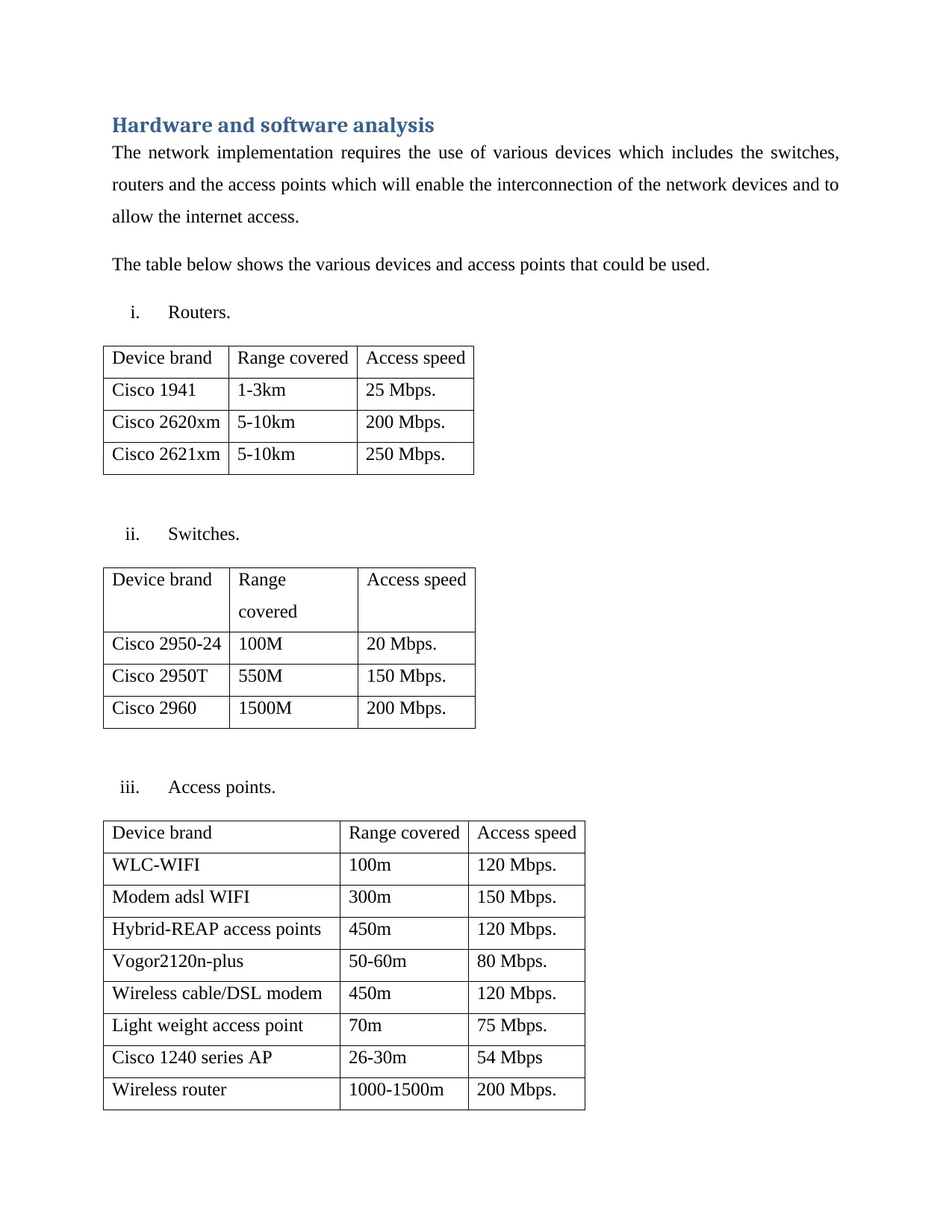
Hardware and software analysis
The network implementation requires the use of various devices which includes the switches,
routers and the access points which will enable the interconnection of the network devices and to
allow the internet access.
The table below shows the various devices and access points that could be used.
i. Routers.
Device brand Range covered Access speed
Cisco 1941 1-3km 25 Mbps.
Cisco 2620xm 5-10km 200 Mbps.
Cisco 2621xm 5-10km 250 Mbps.
ii. Switches.
Device brand Range
covered
Access speed
Cisco 2950-24 100M 20 Mbps.
Cisco 2950T 550M 150 Mbps.
Cisco 2960 1500M 200 Mbps.
iii. Access points.
Device brand Range covered Access speed
WLC-WIFI 100m 120 Mbps.
Modem adsl WIFI 300m 150 Mbps.
Hybrid-REAP access points 450m 120 Mbps.
Vogor2120n-plus 50-60m 80 Mbps.
Wireless cable/DSL modem 450m 120 Mbps.
Light weight access point 70m 75 Mbps.
Cisco 1240 series AP 26-30m 54 Mbps
Wireless router 1000-1500m 200 Mbps.
The network implementation requires the use of various devices which includes the switches,
routers and the access points which will enable the interconnection of the network devices and to
allow the internet access.
The table below shows the various devices and access points that could be used.
i. Routers.
Device brand Range covered Access speed
Cisco 1941 1-3km 25 Mbps.
Cisco 2620xm 5-10km 200 Mbps.
Cisco 2621xm 5-10km 250 Mbps.
ii. Switches.
Device brand Range
covered
Access speed
Cisco 2950-24 100M 20 Mbps.
Cisco 2950T 550M 150 Mbps.
Cisco 2960 1500M 200 Mbps.
iii. Access points.
Device brand Range covered Access speed
WLC-WIFI 100m 120 Mbps.
Modem adsl WIFI 300m 150 Mbps.
Hybrid-REAP access points 450m 120 Mbps.
Vogor2120n-plus 50-60m 80 Mbps.
Wireless cable/DSL modem 450m 120 Mbps.
Light weight access point 70m 75 Mbps.
Cisco 1240 series AP 26-30m 54 Mbps
Wireless router 1000-1500m 200 Mbps.
⊘ This is a preview!⊘
Do you want full access?
Subscribe today to unlock all pages.

Trusted by 1+ million students worldwide
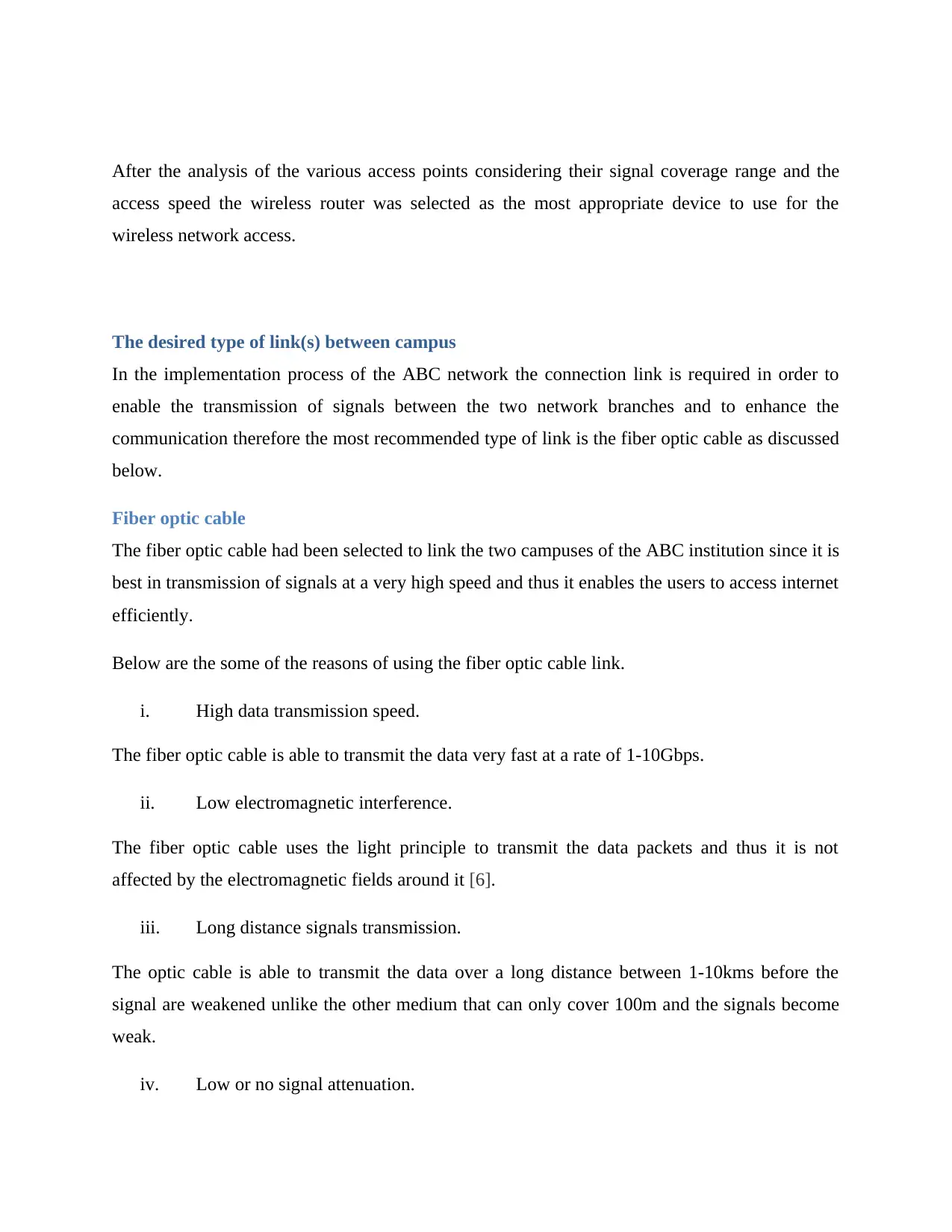
After the analysis of the various access points considering their signal coverage range and the
access speed the wireless router was selected as the most appropriate device to use for the
wireless network access.
The desired type of link(s) between campus
In the implementation process of the ABC network the connection link is required in order to
enable the transmission of signals between the two network branches and to enhance the
communication therefore the most recommended type of link is the fiber optic cable as discussed
below.
Fiber optic cable
The fiber optic cable had been selected to link the two campuses of the ABC institution since it is
best in transmission of signals at a very high speed and thus it enables the users to access internet
efficiently.
Below are the some of the reasons of using the fiber optic cable link.
i. High data transmission speed.
The fiber optic cable is able to transmit the data very fast at a rate of 1-10Gbps.
ii. Low electromagnetic interference.
The fiber optic cable uses the light principle to transmit the data packets and thus it is not
affected by the electromagnetic fields around it [6].
iii. Long distance signals transmission.
The optic cable is able to transmit the data over a long distance between 1-10kms before the
signal are weakened unlike the other medium that can only cover 100m and the signals become
weak.
iv. Low or no signal attenuation.
access speed the wireless router was selected as the most appropriate device to use for the
wireless network access.
The desired type of link(s) between campus
In the implementation process of the ABC network the connection link is required in order to
enable the transmission of signals between the two network branches and to enhance the
communication therefore the most recommended type of link is the fiber optic cable as discussed
below.
Fiber optic cable
The fiber optic cable had been selected to link the two campuses of the ABC institution since it is
best in transmission of signals at a very high speed and thus it enables the users to access internet
efficiently.
Below are the some of the reasons of using the fiber optic cable link.
i. High data transmission speed.
The fiber optic cable is able to transmit the data very fast at a rate of 1-10Gbps.
ii. Low electromagnetic interference.
The fiber optic cable uses the light principle to transmit the data packets and thus it is not
affected by the electromagnetic fields around it [6].
iii. Long distance signals transmission.
The optic cable is able to transmit the data over a long distance between 1-10kms before the
signal are weakened unlike the other medium that can only cover 100m and the signals become
weak.
iv. Low or no signal attenuation.
Paraphrase This Document
Need a fresh take? Get an instant paraphrase of this document with our AI Paraphraser
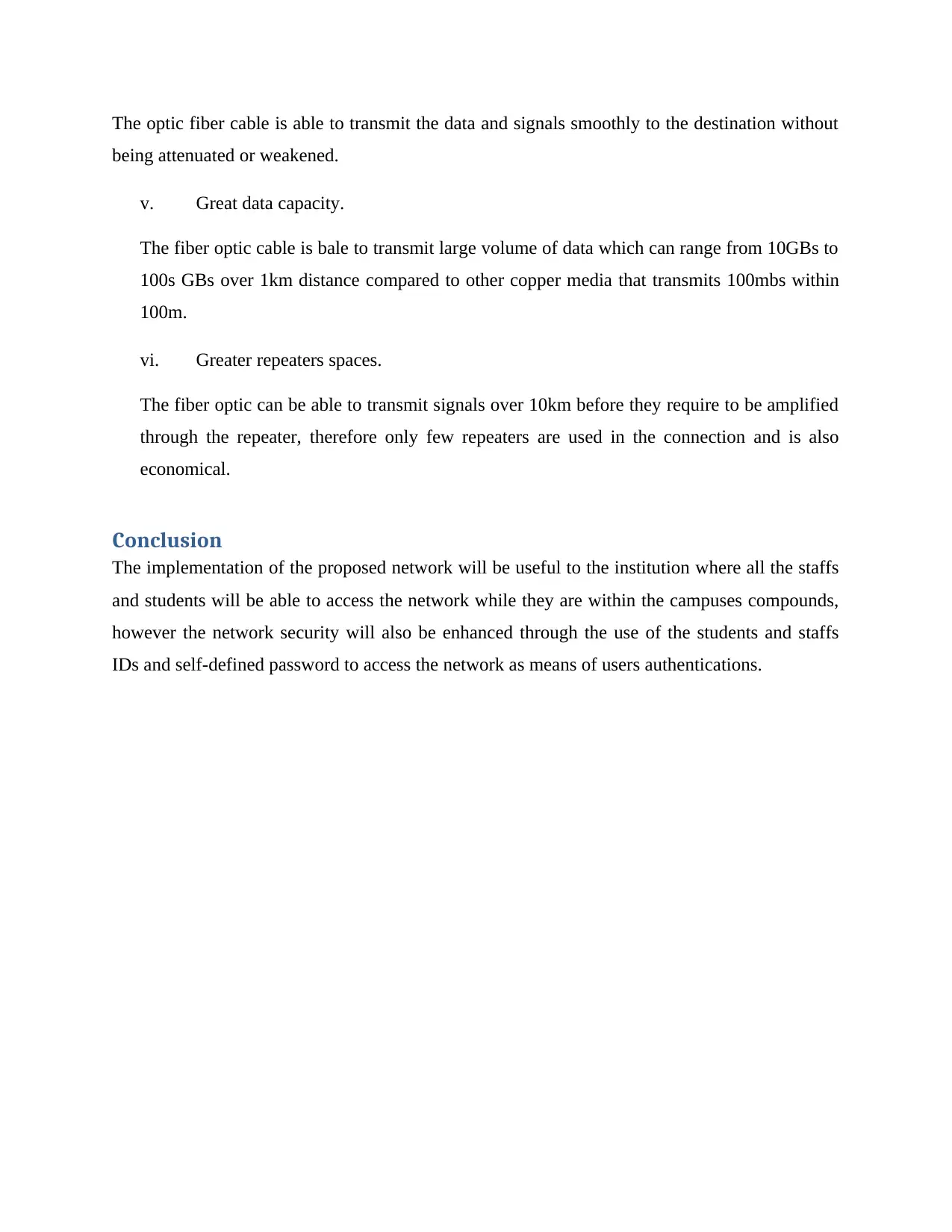
The optic fiber cable is able to transmit the data and signals smoothly to the destination without
being attenuated or weakened.
v. Great data capacity.
The fiber optic cable is bale to transmit large volume of data which can range from 10GBs to
100s GBs over 1km distance compared to other copper media that transmits 100mbs within
100m.
vi. Greater repeaters spaces.
The fiber optic can be able to transmit signals over 10km before they require to be amplified
through the repeater, therefore only few repeaters are used in the connection and is also
economical.
Conclusion
The implementation of the proposed network will be useful to the institution where all the staffs
and students will be able to access the network while they are within the campuses compounds,
however the network security will also be enhanced through the use of the students and staffs
IDs and self-defined password to access the network as means of users authentications.
being attenuated or weakened.
v. Great data capacity.
The fiber optic cable is bale to transmit large volume of data which can range from 10GBs to
100s GBs over 1km distance compared to other copper media that transmits 100mbs within
100m.
vi. Greater repeaters spaces.
The fiber optic can be able to transmit signals over 10km before they require to be amplified
through the repeater, therefore only few repeaters are used in the connection and is also
economical.
Conclusion
The implementation of the proposed network will be useful to the institution where all the staffs
and students will be able to access the network while they are within the campuses compounds,
however the network security will also be enhanced through the use of the students and staffs
IDs and self-defined password to access the network as means of users authentications.
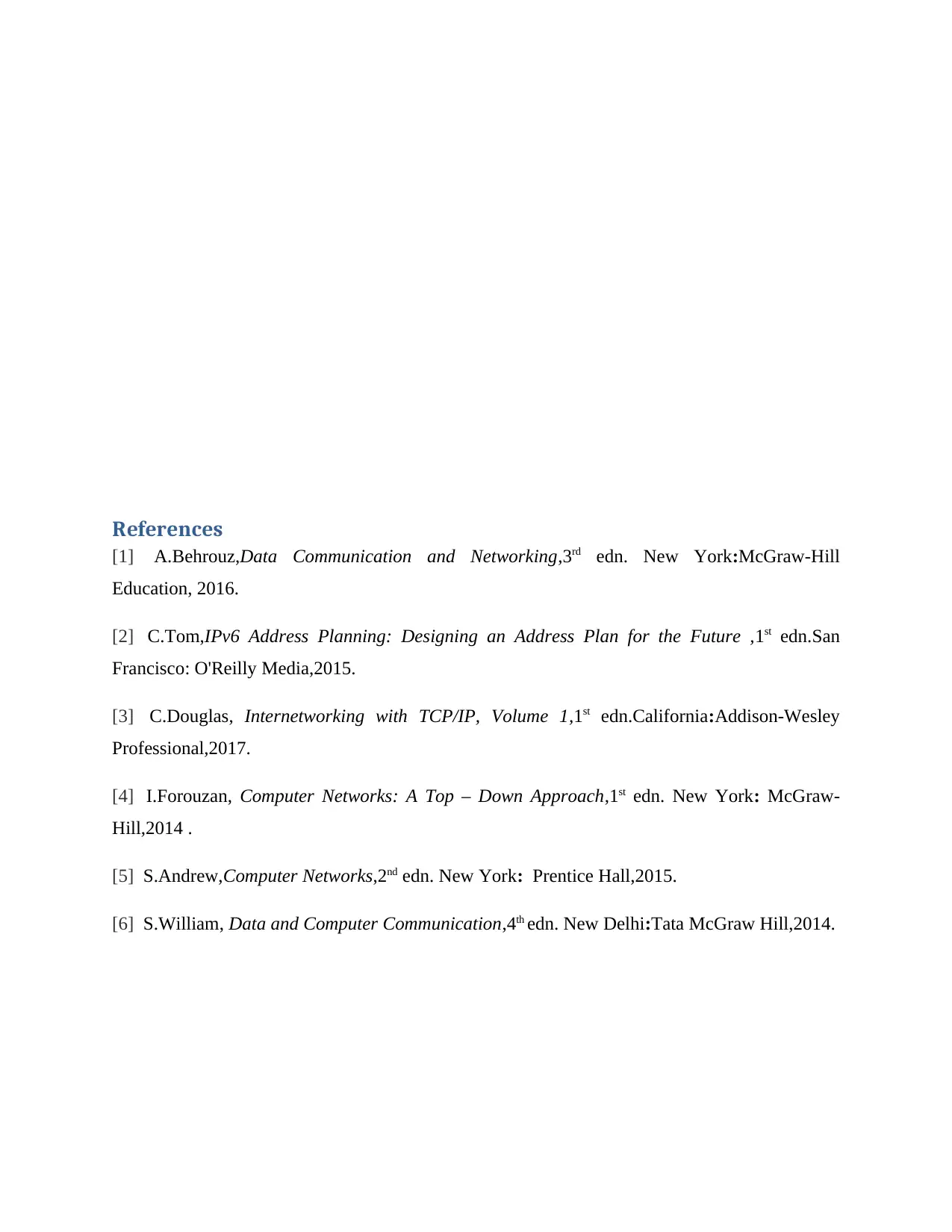
References
[1] A.Behrouz,Data Communication and Networking,3rd edn. New York:McGraw-Hill
Education, 2016.
[2] C.Tom,IPv6 Address Planning: Designing an Address Plan for the Future ,1st edn.San
Francisco: O'Reilly Media,2015.
[3] C.Douglas, Internetworking with TCP/IP, Volume 1,1st edn.California:Addison-Wesley
Professional,2017.
[4] I.Forouzan, Computer Networks: A Top – Down Approach,1st edn. New York: McGraw-
Hill,2014 .
[5] S.Andrew,Computer Networks,2nd edn. New York: Prentice Hall,2015.
[6] S.William, Data and Computer Communication,4th edn. New Delhi:Tata McGraw Hill,2014.
[1] A.Behrouz,Data Communication and Networking,3rd edn. New York:McGraw-Hill
Education, 2016.
[2] C.Tom,IPv6 Address Planning: Designing an Address Plan for the Future ,1st edn.San
Francisco: O'Reilly Media,2015.
[3] C.Douglas, Internetworking with TCP/IP, Volume 1,1st edn.California:Addison-Wesley
Professional,2017.
[4] I.Forouzan, Computer Networks: A Top – Down Approach,1st edn. New York: McGraw-
Hill,2014 .
[5] S.Andrew,Computer Networks,2nd edn. New York: Prentice Hall,2015.
[6] S.William, Data and Computer Communication,4th edn. New Delhi:Tata McGraw Hill,2014.
⊘ This is a preview!⊘
Do you want full access?
Subscribe today to unlock all pages.

Trusted by 1+ million students worldwide
1 out of 12
Related Documents
Your All-in-One AI-Powered Toolkit for Academic Success.
+13062052269
info@desklib.com
Available 24*7 on WhatsApp / Email
![[object Object]](/_next/static/media/star-bottom.7253800d.svg)
Unlock your academic potential
Copyright © 2020–2025 A2Z Services. All Rights Reserved. Developed and managed by ZUCOL.





